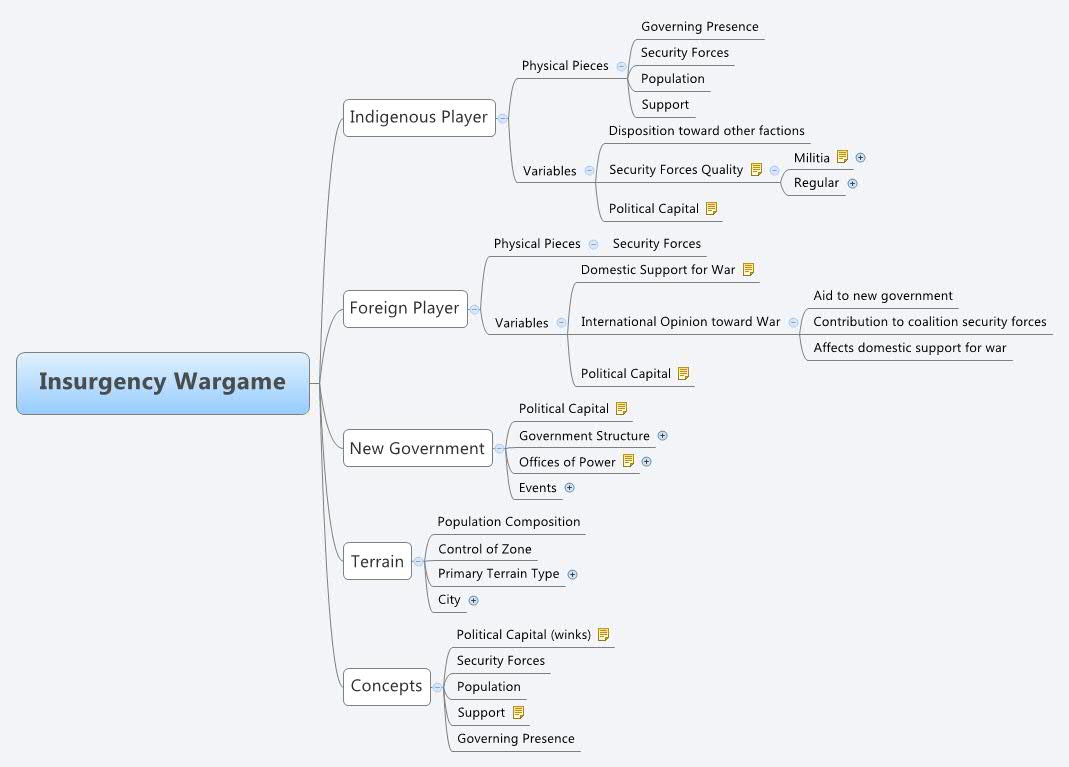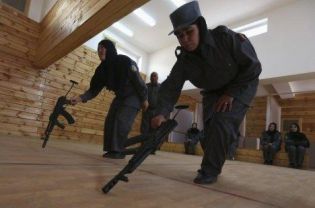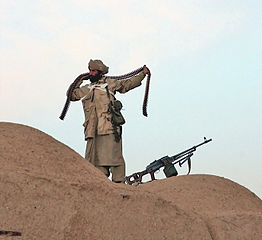Fardh al-Qanoon Simulation: counter sheet, updated map, rules overview
The Fardh al-Qanoon simulation I’ve written about previously has undergone some major changes since I received feedback on my first draft of rules from Dr. Sabin. I’ve basically redesigned the whole simulation, and you can find an overview of the new rule system after the counter sheet and updated map images for version 0.3.1 of the simulation.
Counter sheet

As you can see, there are a total of 68 counters involved in the simulation (the limit for the project is 100, any my first version came dangerously close to that threshold with 96). Unlike before, there are no civilian counters, nor are the Mahdi Army units hidden (thus removing the “limited intelligence” aspect of the game). Hat tip to Rex Brynen at PAXSims for the suggestion to create black militia counters with white print, which looks very thematically-appropriate.
Updated map

The map has been revamped since the version I posted previously, and the changes look even more stark in comparison to the version I included with my first rules submission, which listed all the neighborhood numbers and track values. First of all, all the tracks have been simplified and each district’s factional support is no longer measured. Since the goal of the operation was to secure Baghdad, I decided to simplify how the game works by measuring Coalition Control rather than its level of support in each of the 9 districts. On the other side, the Mahdi Army’s level of dominance (its presence, reputation, and ability to recruit new fighting members) is measured in lieu of support.
The Mahdi Army has a stacking limit in each district, which is identified by the white number on the green silhouette of armed men. The limit was previously determined by the Mahdi Army’s level of support in each district, with an essentially endless supply of units available up to the district limit. Now, the availability of units is limited by the Mahdi Army’s level of Dominance overall. As the Coalition boxes the Madhi Army in one district at a time (as, ideally, they should be doing in the game if they hope to win), they’ll find themselves facing ever-larger numbers of militia as they reach the core areas of Mahdi control in Sadr City and other Shia-populated districts in east Baghdad.
Under the previous rule system, it was possible to try to lock the Mahdi Army out of a district by securing support in it and lowering Mahdi support, thus limiting the number of units they could deploy to build their support back up. With the factional support system gone, districts are now locked by securing the neighborhoods themselves. The Coalition has 18 units (which do not represent all personnel in Baghdad, but rather the personnel they could use for patrol, raids, and reconstruction at any given time in a month) and there are 25 neighborhood zones. They must, therefore, work on securing neighborhoods by flushing the Mahdi Army out and establishing a permanent physical presence. The establishment of Joint Security Stations allows the Coalition to free up units for other missions while keeping a neighborhood secure, though the Mahdi Army can attempt to break the secure atmosphere by sneaking forces in.
What has not changed since the last version is the Sunni faction, which is still present and affected in two ways: Coalition-Sunni relations, and Sunni empowerment. As the former increases, Sunni acts of violence and terrorist acts become less likely, while the latter determines how many Sunni events occur each month. The Mahdi Army player will want to suppress Sunni empowerment to decrease violence against Shias (since defending against Sunni attacks takes resources away from hampering the Coalition) and make terrorist attacks less likely, while the Coalition player will want to improve its relations with the Sunni community for the same ends (since sectarian violence and terrorist attacks hamper its ability to secure control and increase Mahdi power).
I will post version 0.3.2 of the rules after I receive some feedback from Dr. Sabin on the current version tomorrow, so look for that late on Wednesday or on Thursday.










Design is very aesthetically pleasing. Look forward to playing!